Global Inspiration: Cuisines of Europe and the Americas
INGREDIENTS
The foods of Central and South America are growing more popular with consumers in the United States, while the cuisines of many European countries are being rethought and reinterpreted to give consumers new taste and flavor experiences. And regional American cuisines are showing the diversity of foods and ingredients in the United States, illustrating that there is no one defining style of American food. Culinary professionals are giving their own spin on cuisines of the Americas and Europe in restaurants around the world while product developers inspired by ingredients and flavors of the cuisines are formulating with newly developed ingredients to produce consumer packaged goods that allow consumers to enjoy elements of these cuisines at home.
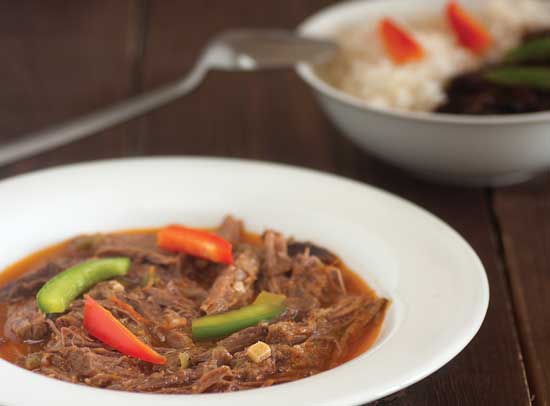 Global Food Cultures and Culinary Insights
Global Food Cultures and Culinary Insights
Blending tradition and heritage, chefs today are putting their own spin on ingredients and cuisines of their homelands as well as bringing their own interpretations to cuisines that inspire them. Many of these chefs showcased their culinary innovations during the 18th annual Worlds of Flavor International Conference & Festival at the Culinary Institute of America, St. Helena, Calif., in April (worldsofflavor.com).
With the theme On Fire: Culture, Passion, Invention: Europe and the Americas, the event organizers gathered a number of professional chefs and food writers to provide insights into cuisines from across North America, Central America, South America, and Europe to show how these cuisines have evolved under the direction of these enterprising chefs. “This year we wanted to look at inward connections and how chefs the world over have deepened the relationship they have with their own cuisine and made it their own,” Anne McBride, culinary program and editorial director for strategic initiatives at the CIA told the audience that gathered at the opening ceremony.
Through seminars and cooking demonstrations, the chefs explained what made them so passionate about a particular cuisine. Take Enrique Olvera, chef-owner of Pujol in Mexico City and Cosme in New York, for example. He explained that as he became disenchanted with some aspects of fine dining, he was finding inspiration in the street foods of Mexico, so much so that he incorporated what he finds interesting about street foods into the menu at his restaurant Cosme. Or Tanya Holland, who has brought her own brand of soul food with Creole influences to her Brown Sugar Kitchen restaurant in Oakland, Calif. Matthew Accarrino combines elements of the cuisine of his heritage—Italian—with local ingredients from Northern California at his San Francisco restaurant SPQR. And then there are Samantha and Cody Carroll, chef-owners of Sac-a-lait in New Orleans and Hot Tails in New Road, La., who celebrate the food from their roots in the Cajun area of southern Louisiana as well as the diverse ingredients from Creole cuisine.
Other chefs highlight ingredients indigenous to their location. Virgilio Martinez, chef-owner of Central in Lima, Peru, focuses on the Peruvian landscapes and the local ingredients, and Stuart Brioza, chef-owner of State Bird Provisions, San Francisco, who incorporates Bay area seafood on his menu. Conference attendees also heard from chefs and food writers who explained how the cuisines we may think of as Peruvian, Panamanian, Spanish, Creole, and many more were shaped by the immigrants who brought their own culinary traditions to these areas. In particular, they talked about the influences that Africans, Europeans, and Asians had on cuisines throughout the Americas. For example, Mitsuharu Tsumura, chef-owner of Maido in Lima, Peru, pointed out that Peru is a melting pot of cultures—Italian, Chinese, Japanese, African, and Spanish—that have left their mark on Peruvian cuisine. Tsumura, a Peruvian of Japanese descent, specializes in Nikkei cuisine, which combines Japanese techniques with Peruvian ingredients. Speaking about Southern food, Chandra Ram, editor of Plate, who grew up in Lexington, Ky., summed it up best by saying that the standard dishes of classic Southern food developed from the cultures and traditions of people who shaped the south hundreds of years ago, including people from Europe, Central America, Africa, India, and various nations in Asia.
A final point that the chefs mentioned is about how they refine and reinterpret culinary traditions but also maintain respect for them. Steeped in tradition, the classic techniques from French cooking have been the mainstay in culinary schools and restaurants the world over. “If you’re a chef anywhere in the world, whether you are French or not, you’re speaking French if you’re cooking at some level in the kitchen, and if you are a chef from France—whatever region you’re from—there is a weight of tradition that you’re dealing with and interpreting all the time,” said Beth Kracklauer, food and drinks editor at The Wall Street Journal. David Toutain, chef-owner of Restaurant David Toutain, Paris, has helped continue the evolution of French cuisine through his use of local ingredients and the blending of traditional French techniques he was trained in with international influences from his work in restaurants around the world.
Flavor Trends Shaping Product Development
What do nostalgic and regional American food, Cuban cuisine, and global street food have in common? As part of its 2016 Spark trends program, Bell Flavors & Fragrances, Northbrook, Ill. (bellff.com), named these three (out of five total) as influential trends. Each highlights foods and ingredients from regions in Europe and the Americas, showing how these areas continue to have culinary influences product developers can draw upon in product development efforts.
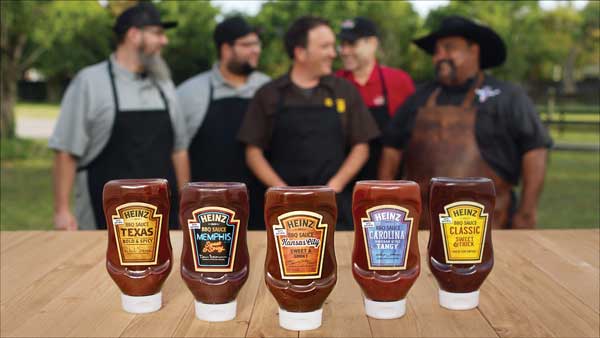 Nostalgic and regional American food—what Bell calls Americana—focuses on the fact that there are regional differences in terms of foods and flavor preferences across the United States and that these can be explored further by reinventing and modernizing classic dishes or using ingredients in nontraditional applications. By providing a number of product concept ideas, the Spark trend report shows how classic flavors such as brown butter, birch, watermelon, molasses, sarsaparilla, chow chow spice, maple, and rhubarb get modern twists when used in such products as beverages (grape ginger ale, butterscotch root beer, and apple pie cider soda) and desserts (huckleberry thyme ice cream topped with brown butter molasses crumble). Kelli Heinz, director of marketing and industry affairs at Bell, says that her research shows that many of these flavors are being called out more on consumer packaged goods. The trend also includes the idea of putting flavor spins on traditional dishes like casseroles (try a savory cobbler made from fresh tomatoes topped with blue cheese biscuits) and celebrating the variety of regional American food in new ways (top a toasted garlic bread crust with Texas barbecue sauce, slow-smoked brisket, Cheddar jack cheese, and green onions to make Texas brisket pizza). There is also something that Bell calls “jars of regional pride”—basically sauces from specific regions around the country like huli huli sauce from Hawaii, giardiniera from Chicago, or Cajun sauce from southern Louisiana. Overall, the Americana trend demonstrates the regional pride of American cuisines, says Heinz, as well as the understanding that there is a vast difference in foods and ingredients used throughout the country.
Nostalgic and regional American food—what Bell calls Americana—focuses on the fact that there are regional differences in terms of foods and flavor preferences across the United States and that these can be explored further by reinventing and modernizing classic dishes or using ingredients in nontraditional applications. By providing a number of product concept ideas, the Spark trend report shows how classic flavors such as brown butter, birch, watermelon, molasses, sarsaparilla, chow chow spice, maple, and rhubarb get modern twists when used in such products as beverages (grape ginger ale, butterscotch root beer, and apple pie cider soda) and desserts (huckleberry thyme ice cream topped with brown butter molasses crumble). Kelli Heinz, director of marketing and industry affairs at Bell, says that her research shows that many of these flavors are being called out more on consumer packaged goods. The trend also includes the idea of putting flavor spins on traditional dishes like casseroles (try a savory cobbler made from fresh tomatoes topped with blue cheese biscuits) and celebrating the variety of regional American food in new ways (top a toasted garlic bread crust with Texas barbecue sauce, slow-smoked brisket, Cheddar jack cheese, and green onions to make Texas brisket pizza). There is also something that Bell calls “jars of regional pride”—basically sauces from specific regions around the country like huli huli sauce from Hawaii, giardiniera from Chicago, or Cajun sauce from southern Louisiana. Overall, the Americana trend demonstrates the regional pride of American cuisines, says Heinz, as well as the understanding that there is a vast difference in foods and ingredients used throughout the country.
Improved domestic relations between the United States and Cuba, including the easing of trade and travel restrictions, has generated renewed interest in Cuba. One area of excitement is the cuisine and culinary traditions of the island nation. For its Spark trend, The Well-Traveled Kitchen: Cuba, Bell points to popular Cuban delicacies such as ropa vieja (shredded beef slow braised in tomato sauce with garlic, peppers, and onions) and medianoche (a grilled ham, Swiss cheese, mustard, and sour orange-marinated roast pork sandwich on sweet egg bread) as inspiration for developing a line of flavors that can give foods and beverages the tastes of Cuban cuisine. Other dishes that Bell points to are pastelitos (puff pastry filled with either sweet or savory ingredients), picadillo empanadas (a handheld snack made from ground meat simmered in wine, tomatoes, raisins, and olives that is wrapped in flaky dough and baked), and the El Presidente drink (a combination of dark rum, curacao, white vermouth, and grenadine). Plantain, green olive, paprika, mango, and sour orange are some of the ingredients and flavors of Cuban cuisine that consumers can expect to see more of on restaurant menus and in packaged goods, says Heinz.
At the company’s annual Flavorology event held this past May in Chicago, its application specialists showed key customers how to add Cuban flair to food products with such product concepts as doughnuts made with a guava-flavored fruit prep and mascarpone cheese-flavored frosting and a yerba mate soda based on a popular Cuban drink, Materva, which is made from yerba mate. Perhaps manufacturers of frozen entrees and foodservice operators might find interest in the Havana bowl product concept made from garlic rice, sofrito-seasoned black beans, ropa vieja, fried sweet plantain, and cilantro drizzle. And manufacturers of spirits can add flavor depth to beverages like whiskey, bourbon, and vodka with different flavoring ingredients. The cleverly named Close, But No Cigar Whiskey product concept featured Bell’s Tobacco Type Flavor, Natural & Artificial, which imparted smoky notes similar to those in smoked meat and a sweet resin taste found in tobacco, says Heinz. The company’s flavor specialists went one step further with a product concept developed for the Research Chefs Association conference held earlier this year in Denver by combining regional American flavors with elements of Cuban cuisine. The Colorado Cuban layered agave-pine brined wild boar ham and mojo lamb shoulder with amber ale–flavored pickles and huckleberry-flavored mustard. “That was probably one of our tastiest products we’ve made,” says Heinz.
--- PAGE BREAK ---
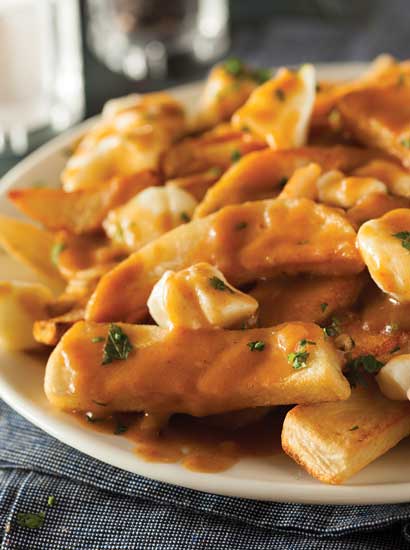 In many countries around the world, makeshift food stalls and colorful food markets allow people to grab a quick, freshly made meal on the go—what we call street food. The rise of food trucks across America gives people here an opportunity to experience a kind of street food movement as well. More than ever, street food in its varying forms provides product development opportunities to both food manufacturers and culinary professionals. The Spark trend report features examples of delicious street food found in five cities, three of which—Montreal, Berlin, and Mexico City—fit into the topic of this article. By choosing global street food as a trend, Heinz explains that the company is highlighting some of the traditional dishes from select regions and the flavors used to make those dishes. Some of the dishes have already appeared on menus and on store shelves across the United States. Heinz has seen the popular food in Montreal called poutine—French fries topped with aged cheese curds and spiced gravy—on restaurant menus in many diverse regions around the country. She even notes how some creative chefs have put their own spin on poutine by incorporating elements from other cuisines into the dish, such as the kimchi poutine she spotted at one restaurant.
In many countries around the world, makeshift food stalls and colorful food markets allow people to grab a quick, freshly made meal on the go—what we call street food. The rise of food trucks across America gives people here an opportunity to experience a kind of street food movement as well. More than ever, street food in its varying forms provides product development opportunities to both food manufacturers and culinary professionals. The Spark trend report features examples of delicious street food found in five cities, three of which—Montreal, Berlin, and Mexico City—fit into the topic of this article. By choosing global street food as a trend, Heinz explains that the company is highlighting some of the traditional dishes from select regions and the flavors used to make those dishes. Some of the dishes have already appeared on menus and on store shelves across the United States. Heinz has seen the popular food in Montreal called poutine—French fries topped with aged cheese curds and spiced gravy—on restaurant menus in many diverse regions around the country. She even notes how some creative chefs have put their own spin on poutine by incorporating elements from other cuisines into the dish, such as the kimchi poutine she spotted at one restaurant.
Consumers are also finding influences of these global street foods in packaged goods at the grocery store in a couple of different ways. Beverage manufacturers have produced packaged versions of horchata, a sweet cinnamon and rice-based beverage popular in Mexico. In addition to these packaged horchata beverage products, Heinz says horchata flavor is being used in non-beverage packaged goods such as confections and ice cream. “A lot of these global flavor elements can go into many different applications,” she notes. She’s seen snack foods, for instance, that are poutine-flavored or flavored with elements from currywurst, a steamed and fried pork bratwurst topped with curry sauce and Madras curry powder popular in the Berlin street food scene.
Sauces, Seasonings for Global Twists
Let’s switch gears to consider ingredients like herbs, spices, seasoning blends, and sauces—flavorful and versatile ingredients that add global flair and flavors to foods and beverages and stay true to traditional recipes. In fact, “ethnic condiments/spices” and “authentic ethnic cuisine” are two of the top 20 food trends in the National Restaurant Assoc.’s What’s Hot: 2016 Culinary Forecast (NRA 2016). A new line of seasoning blends and bases that highlight the diversity of Latin American and Spanish cuisines and barbecue sauces that honor the traditions of regional American barbecue give product developers the opportunity to create authentic products or give new applications a different twist of flavor.
The Latin Action Collection from Fuchs North America, Owings Mills, Md. (fuchsna.com), features 10 products geared toward specific applications, such as snacks or sweets. To set snack chips apart from such standard flavors as nacho cheese, chili cheese, or ones that emphasize heat level, there is Elote Street Corn Snack Seasoning, a blend of roasted corn, cheese, chilies, and lime, and Spicy Guacamole Snack Seasoning, made from avocado, citrus, and various spices and chilies. A number of aromatic herbs and spices bring layers of flavors to various types of meat as well as firmer, more flavorful types of fish such as salmon. Cracked Coriander & Green Chili Rub blends coriander with smoky green chilies and lime while Chorizo Sausage Seasoning features spicy peppers, garlic, spices, and herbs. (Don’t let the name fool you; the company promotes the seasoning blend as being perfect for other types of meat and fish.) Rice and other side dishes that accompany meat or fish entrees can be seasoned with a complex blend of saffron, roasted garlic, smoked paprika, and lemon. To develop its Valencia Style Rice Seasoning, Fuchs North America took cues from the culinary traditions of Spain and Portugal.
Cacao has its roots in southern Mexico and parts of Central America, dating back to the time of the Mayan civilization—and maybe even before, according to some researchers—when Mayans consumed a chocolate drink that was made with crushed cocoa beans, chili peppers, and water. Fuchs North America’s Mayan Hot Chocolate blend appeals to our modern tastes as it combines sweet chocolate with spices and smoky peppers. Rounding out the Latin Action Collection are four seasoning blends for sauces and soup bases as well as for potato dishes, vegetables, meat, and seafood, where they add delicious spicy and savory flavors. The blends include Yucatán Chicken & Lime Soup Base, Chipotle Adobo Seasoning Blend, Tomatillo Seasoning Blend, and Chimichurri Argentino.
Now, let’s turn our attention to the southern region of the United States, where cooking food on the grill is a favorite pastime of many. Barbecue is a method of cooking meat over low heat for a long period of time. It has become extremely popular around the country but in no place more than the southern part of the country, where distinct regional barbecue styles exist, each defined by specific meat, techniques, hardwood, and seasonings/sauces that give characteristic flavors, aromas, and textures (even within these regions, there are differences). Asenzya, Oak Creek, Wis. (asenzya.com), reviewed some of the similarities and differences in the barbecue styles, naming the general category of American regional barbecue as a trending flavor (Asenzya 2016). It cites six regions where these distinctions, particularly in the sauces, are apparent: North Carolina, South Carolina, Kansas City, Memphis, Alabama, and Texas.
The tangy, peppery sauce that is typically used in North Carolina barbecue is vinegar-based and generally made from cider vinegar, sugar, and chili flakes. It has a thinner consistency than sauces used in some other barbecue regions. Depending on where you are in South Carolina, the sauce composition differs slightly. The Asenzya report points out that a thinner tomato, mustard-based sauce is used in the western part of the state, a mustard-based sauce in the central region, and a sauce that is similar to that used in North Carolina in the coastal region. The sauce is typically made from yellow mustard with ingredients like brown sugar, black and cayenne peppers, and cider vinegar adding sweet and tangy flavors with some heat. Kansas City barbecue usually includes a sauce that has a stick-to-your ribs quality (it’s a thick, tomato- and molasses-based sauce that clings perfectly to baby back ribs). The tomato-based sauce used in Memphis barbecue is on the thinner side, and can be made from ketchup or tomato paste, hot sauce, vinegar, and sugar. In Alabama, different types of sauce are used, but the one that is unique to the state is a white sauce, which is a combination of mayonnaise, horseradish, lemon juice, cider vinegar, and cayenne pepper. The last barbecue region that the Asenzya report notes is Texas, where beef bristket is typically coated with a dry rub rather than a sauce.
Product developers are always on the lookout for ways to make their products stand out from their competitors, and they can do this with any number of formulation efforts and even with the product name. With regional barbecue, once product developers understand the basic differences between the major barbecue regions, they can then create an advantage in the naming of the product, says Dax Schaefer, corporate executive chef/director of culinary innovation at Asenzya. Take a simple barbecue chicken pizza, formulate it to have flavor profiles similar to a particular barbecue region, and call it out in the product’s name (such as Kansas City-Style Barbecue Chicken Pizza or South Carolina Gold Barbeque Chicken Pizza, says Schaefer). “This simple step will add intrigue and romance to the product in the consumer’s eyes as well as clarify the barbecue profile they should expect. Who wouldn’t want and pay a little more for a South Carolina Gold Barbecue Chicken Pizza versus the generic barbecue chicken?” he asks.
As food manufacturers continue to take this approach, consumers can expect to see more products that call out ways in which the products are different from mainstream versions. Consumers are exposed to a variety of culinary and food information sources, “but no matter what the form, the end result is the same—they are being exposed to more flavor profiles and virtual experiences than ever before,” says Schaefer. “This exposure is directly resulting in higher consumer expectations from brands to deliver these experiences in their products; they know there are more options available to them than just the same old tomato-based barbecue sauce. Suddenly ethnic has not just become very approachable but also very desirable (that includes American regional specialties like barbecue). They like the thought of travel and want to experience that or remember the experience with their food.”
--- PAGE BREAK ---
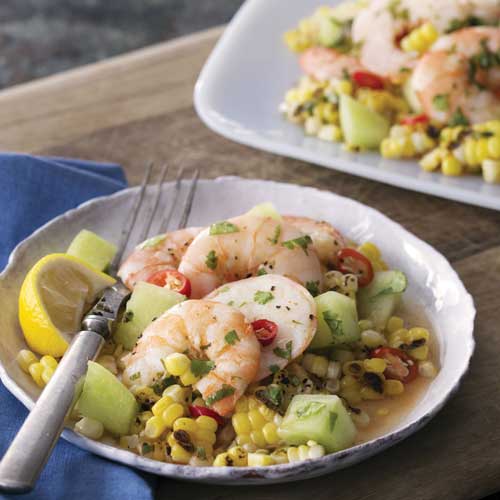 Flavor Exploration
Flavor Exploration
McCormick & Co., Hunt Valley, Md. (mccormickcorporation.com), is no stranger to taking influence from cuisines both near and far and developing products that both consumers and product developers can use to add global flair to all of their food and beverage products. Each year, the company’s panel of food technologists and chefs pinpoint global trends with the potential to influence culinary and product development in the McCormick Flavor Forecast and McCormick Flavor Forecast: Grilling Edition. The 2016 Flavor Forecast report feature a number of flavor and ingredient trends covering cuisines from around the world, among them Mexican, Brazilian, and Creole, to name a few (McCormick 2016a).
Mexico’s rich culinary history continues to evolve and one of the noted trends in the 2016 Flavor Forecast shows how native and “ancient” ingredients combined with other ingredients bring “ancestral flavors” to modern dishes. Amaranth, a protein-packed ancient grain with an earthy, nutty flavor, was a major food crop of the Aztecs thousands of years ago. Today, it gives foods a boost of several important nutrients and is thought to be heart healthy. Amaranth can be used in side dishes, salads, cereal products, bars, and desserts, like the recipe for Dark Chocolate and Cranberry Amaranth Bars that McCormick developed for the 2016 Flavor Forecast. Mezcal, a spirit with smoky, complex flavor, has been produced in Mexico for centuries. For its Marinated Bison with Roasted Tomato Sofrito, McCormick formulated both the marinade and sofrito with a little mezcal. The combination of mezcal, pineapple, cinnamon, nutmeg, and sugar gave the Caramelized Pineapple and Mezcal Margarita sweet, spicy, smoky, and tart tastes.
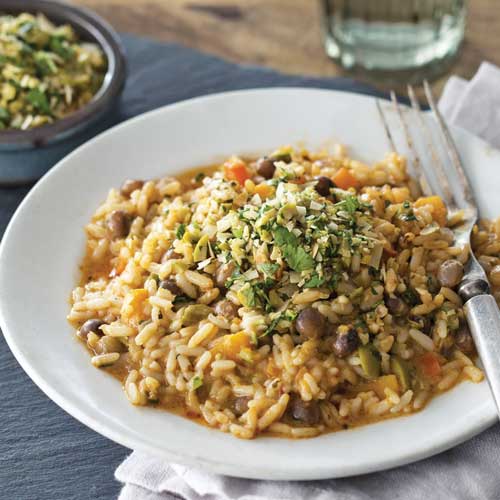 Pulses are a staple ingredient in cuisines around the world used in side dishes, soups, and stews, and as an accompaniment for meat or fish. Caribbean Coconut and Pigeon Pea Rice, a creamy risotto-like dish, is a variation on moro de gandules con coco, a traditional entrée in the Dominican Republic. Pigeon peas are also used as the main filling in a tacos al pastor recipe developed by McCormick, where they are seasoned with a spice blend and paired with a coconut-lime cabbage slaw. Beans like cranberry beans stand in for meat in classic Italian dishes like Bolognese or boost protein and add texture in rustic, Mediterranean-style soups.
Pulses are a staple ingredient in cuisines around the world used in side dishes, soups, and stews, and as an accompaniment for meat or fish. Caribbean Coconut and Pigeon Pea Rice, a creamy risotto-like dish, is a variation on moro de gandules con coco, a traditional entrée in the Dominican Republic. Pigeon peas are also used as the main filling in a tacos al pastor recipe developed by McCormick, where they are seasoned with a spice blend and paired with a coconut-lime cabbage slaw. Beans like cranberry beans stand in for meat in classic Italian dishes like Bolognese or boost protein and add texture in rustic, Mediterranean-style soups.
To take the heat of chili peppers to new levels, try combining them with a tangy ingredient like citrus, as McCormick illustrates with its Peruvian Chicken with Mashed Plantains and Chile Sauce recipe for the 2016 Flavor Forecast. Here, a twist on traditional Peruvian spit-roasted chicken (pollo a la brasa) features marinated grilled chicken paired with two hot and tangy sauces, a green chili sauce made with lime juice, jalapeno pepper, ají amarillo, and a creamy rocoto sauce that features lime and ají rocoto. The company takes heat and tangy flavors further by layering them with smoke flavors for its version of the Creole classic po’ boy sandwich. Heat and smoke flavors come from the Grill Mates Hot Pepper Blackened Seasoning while Charred Orange Thyme Vinegar, a recipe included in the 2016 Flavor Forecast: Grilling Edition, provides the tanginess (McCormick 2016b).
Caribbean cuisine is known for combining fresh ingredients that let flavor shine through. Use Perfect Pinch Caribbean Jerk Seasoning, a blend of red and black pepper, thyme, and allspice, to create a fruity, spicy, and tangy DIY Caribbean Mango Vinegar. The vinegar then becomes an ingredient in a marinade for meat and fish cooked on a grill for a smoky, charred flavor.
Finally, the 2016 Flavor Forecast: Grilling Edition travels to South America—specifically Brazil—to highlight ingredients that give bold flavors to sauces that accompany Brazilian meat skewers. The skewers themselves are popular in Brazilian barbecue restaurants, where various cuts of pork or beef are marinated in a flavorful blend of seasonings, oil, and a tangy, acidic ingredient like red wine vinegar before hitting the grill. In the McCormick recipe, the seasoning blend is made from McCormick Grill Mates Brazilian Steakhouse Marinade. Pair the skewers with Guava Mango Ají Amarillo Sauce made with ají amarillo paste and a blend of several different McCormick herbs and spices. Other options are Red Chimichurri Sauce made with fresh vegetables, cilantro, jalapeno pepper, and herbs and spices, and Grilled Tomato Coconut BBQ Sauce that has heat courtesy of jalapeño pepper, crushed red pepper, ground ginger, and garlic powder and some creaminess from Thai Kitchen Coconut Milk.
Next month’s Ingredients section will take a look at some of the ingredients highlighted at the IFT16 food expo in Chicago.
Chili Pepper New Mexicans Call Their Own
New Mexico is a state with its own signature chili pepper. The Hatch chili pepper, developed at the Agricultural Experiment Station—later to become New Mexico State University—is named for Hatch Valley, the area in which it is grown and harvested. With a thick green skin, the chili peppers are best roasted before being chopped and added to any number of applications, where they add a bright flavor and a moderate amount of heat. While roasted and chopped Hatch chili peppers are suited for sauces, salsas, marinades, and fillings for tacos and enchiladas, Sensient Natural Ingredients, Turlock, Calif. (sensientnaturalingredients.com), recently developed a Hatch chili pepper powder that allows product developers to include the flavor of the pepper in all types of applications, including ones in which using a fresh chili pepper might be difficult (and ones not associated with chili peppers). Why not blend the Hatch chili powder in dips, mayonnaise, or chowder? It can also be added to pancake batter or in a base to make potato croquettes. Sensient Natural Ingredients offers up more application ideas for its Hatch chili powder, such as Bleu Cheese & Hatch Chili Sliders and Chicken & Hatch Chili Empanadas. The powder is easily incorporated into sweet applications, too, like jelly, peanut brittle, and ice cream.
Flavors of Brazil
With the 2016 Summer Olympics held in Rio, there’s an increased interest in Brazilian culture, including the cuisine. Recognizing this, Comax Flavors, Melville, N.Y. (comaxflavors.com), in July released its Nod to Brazil flavor collection, which includes Brazil Nut Cake, Cachaça, Brigadiero, Chimarrão, and Caipirinha flavorings.
These flavors are inspired by popular foods and beverages enjoyed around Brazil. Cachaça is a distilled spirit made from fermented sugarcane juice and is considered the national spirit of Brazil. It’s the alcohol used to make Brazil’s national cocktail, the caipirinha (sugar and lime are the other two ingredients). Chimarrão is a style of yerba mate with a strong grassy and herbaceous flavor that is brewed like tea. Brigadiero, a traditional confection in Brazil, is a chewy chocolate bite-sized fudge ball rolled in chocolate sprinkles.
 Karen Nachay,
Karen Nachay,
Senior Associate Editor
[email protected]
References
Asenzya. 2016. Trending Flavors: American Regional Barbecue. Oak Creek, Wis. asenzya.com.
McCormick. 2016a. McCormick Flavor Forecast 2016. McCormick & Co., Hunt Valley, Md. mccormickcorporation.com.
McCormick. 2016b. McCormick Flavor Forecast: Grilling Edition 2016.
NRA. 2016. What’s Hot: 2016 Culinary Forecast. National Restaurant Association, Washington, D.C. restaurant.org.
